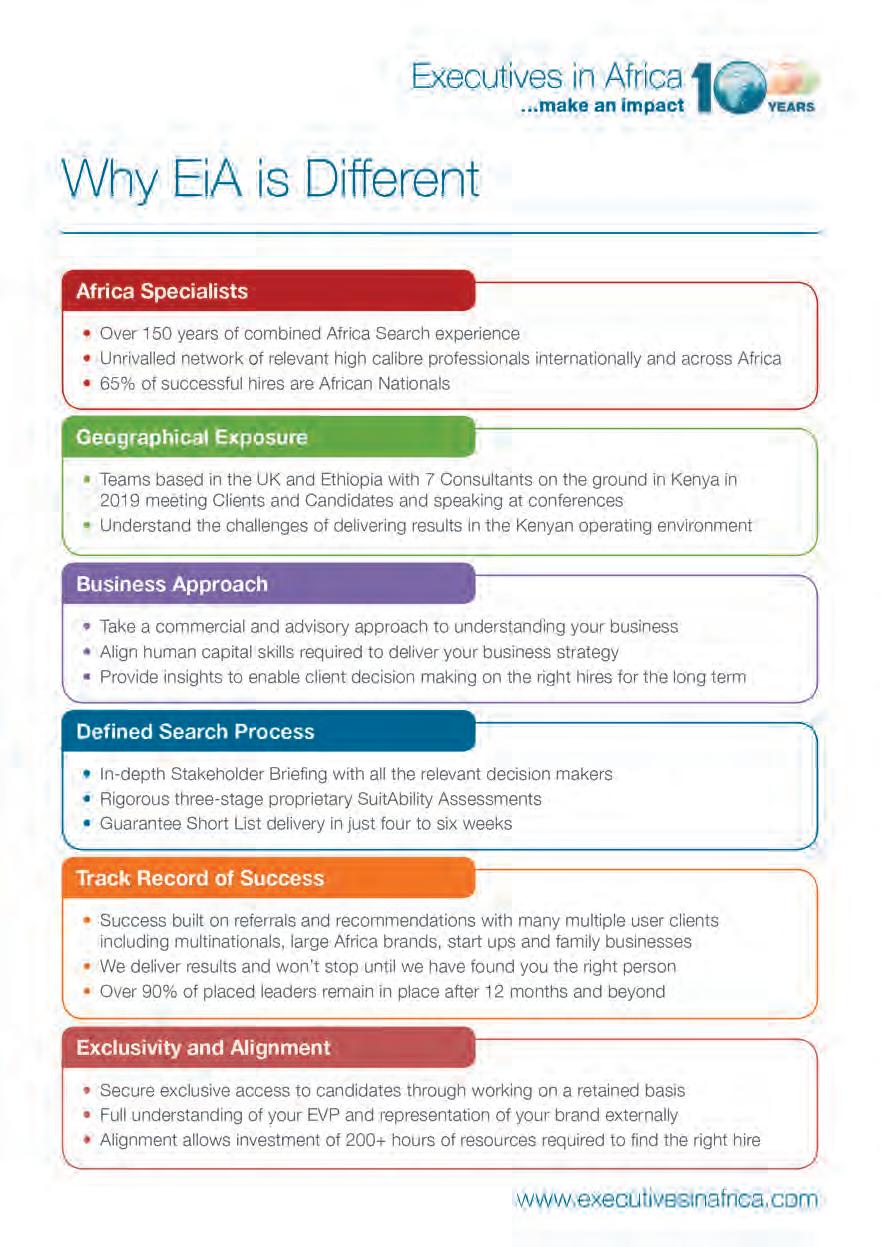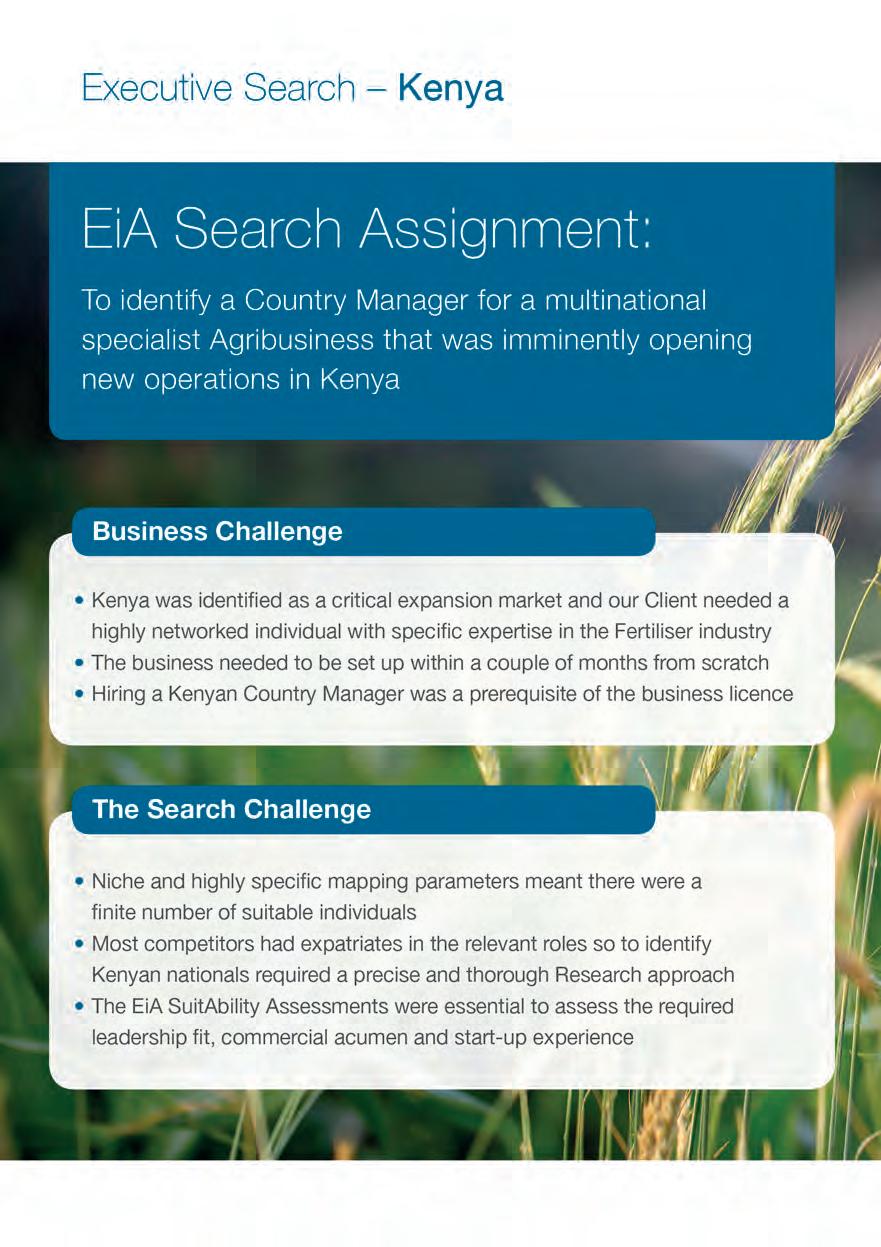
11 minute read
Why Kenya?
KENYA? WHY

Advertisement
Why Kenya?

Summary
Area:
582,650 km2
Population:
48.69 million
GDP per capita:
US $2,039.1
Annual inflation rate:
5.3%
Urban population:
27.5%
General government gross debt:
68.7% of GDP
Population growth rate:
2.275% change
Capital city:
Nairobi
Official language:
Swahili, English

Currency:
Kenyan Shilling
Nominal GDP:
US $99.3 billion
Fiscal balance:
-8.4 of GDP
Current account balance:
-4.8 of GDP/US $-4.7 billion
Exports of goods to UK:
£321 million
Exports of services to UK:
£286 million
Imports of goods from UK:
£384 million
Real annual GDP growth:
0.1%
Imports of services from UK:
£416 million
[Source – FCDO Economics Unit (May 2021), FCDO Overseas Business Risk: Kenya]
Kenya’s strategic location makes the country a hub for East Africa. Its deep-water port, skilled labour, macroeconomic stability and developed banking sector have allowed the country to become East Africa’s largest economy, and the sixth largest in Sub-Saharan Africa. 65% of Kenya’s GDP comes from the greater Nairobi area and many international businesses are deciding to set up their African headquarters in Nairobi. For the last few years, there has been a steady growth of 5-6%.
Exports of goods and services to the UK totalled £607 million in April 2021 and imports of goods and services reached a value of £800 million. More than 150 UK companies operate in Kenya and four of the top six private sector Kenyan taxpayers are British companies. The two biggest employers in Kenya are British firms.
Agriculture, manufacturing, and services sectors are particularly integral to the Kenyan economy. Tourism also brings in a significant amount of foreign capital.
[Source – FCDO Overseas Business Risk: Kenya]
Geography
The East African country is bordered by South Sudan and Ethiopia to the north, the Indian Ocean and Somalia to the east, Tanzania to the south and Uganda to the west. The equator also runs horizontally throughout the country.
Seasonal climates are affected by the pressure system of the Indian Ocean and the landmasses adjacent to it. December to March tends to be fairly dry, although winds do occur north and south of the equator.
March to May is the country’s rainy season, and from June to August there is little precipitation and winds.
The Rift Valley, also known as the Central Rift, is a region that runs through Kenya. Other regions include the Lake Victoria basin, eastern plateau forelands, coastline and semi-arid and arid areas in the north and south.
Government
The last election in Kenya took place in August 2017, for all levels of government. These elections have regularly taken place since 1992.
Tensions have occurred and have led to violence, such as during the 2007 elections. In 2013, however, the elections were relatively peaceful and were followed by President Uhuru Kenyatta and Deputy President William Ruto’s inaugurations.
For the 2017 elections, international support meant that many of the institutions were strengthened and were able to deliver accepted election results. They have a relatively free press in Kenya, and conditions have been put into place on the electoral process. Therefore campaigns are more peaceful and based on wider issues, as opposed to just ethnic identity.
Economic growth is low during election years; in 2007 to 2008 the country suffered a crisis, where growth fell to zero. During the 2017 election, the Central Bank of Kenya downplayed the negative effects, naming it a cyclical effect that will be outlasted by the economic long-term fundamentals. Between May and September 2017, business with the government slowed down due to campaigning and as the new government was installed. Kenya has a market-based economy and a liberalised foreign trade policy. Economic expansion has been encouraged through government policy which welcomes foreign domestic investment and strengthens exports. This encouragement is likely to remain.

In 2010, a new constitution was adopted which gave significant power and resources to 47 new county government structures. This constitution was intended to break the over-centralised system that failed previous governments.
New opportunities for public accountability have arisen as separate branches of national government gain independence from their executive branches.
Information on governmental risks, such as political demonstrations, can be found on the FCDO Foreign travel advice pages: https://www.gov.uk/foreign-travel-advice /kenya.
[Source – FCDO Overseas Business Risk: Kenya]
Economic overview
Kenya has the largest GDP in southeast and central Africa, with a population of over 48 million. The country is currently a member of an intergovernmental organisation, the East African Community (EAC).
There are over 150 UK companies operating in Kenya, including Barclays, British Airways, BAT, Standard Chartered, Diageo, GlaxoSmithKline, Unilever, De La Rue, Finlays, G4S, Tullow Oil and BG Group.
The World Bank has recorded that Kenya’s growth in GDP was expected to be 5.7% by

the end of 2019, slightly lower than its 5.8% growth in 2018. The country, however, in 2020 still exceeded Sub-Saharan Africa’s average growth rate of 1.4%, which it has maintained since 2009.
Growth in 2018 and 2019 has depended on successful harvests, the country’s strong services sectors, a rise in the confidence of companies investing into Kenya and a stable macroeconomic environment. Growth in previous years has been caused by low oil prices, a rise in its agricultural performance, its supportive monetary policy and investments that had been made into the country’s infrastructure. There are vulnerabilities in Kenya’s economy, which include investors who may decide to defer investment during elections, and election-related expenditure leading to infrastructure spending being cut back. From a global perspective, security threats can occur and changes in monetary policy in industrialised countries can lead to pressure on currency if they trigger volatility in financial markets.

[Source – World Bank, DIT: Doing business in Kenya: Kenya trade and export guide]
Kenya’s port has meant that the country has become the entry point for goods that are being exported to its landlocked neighbours, further adding to its economy. The country’s liberalised economy encourages the free flow of trade and the government has backed foreign private investment through its policies and business reforms. As the competition for capital grows in the top markets of Africa, Kenya has made plans to abolish restrictions on foreign shareholdings in listed companies.
Special economic zones (SEZs) have also had a law enacted upon them that provides investment incentives, including tax benefits and additional work permits for skilled foreign employees. All foreign workers must have work permits, and the Kenyan Government states that they must either be in key senior management positions or have skills that are not available from a local worker.
One of the top contributors to Kenya’s GDP is its agriculture sector at 26%. Its main exports are cut flowers, coffee and tea due to their high quality. Around 70% of the country’s rural population works in the agriculture sector which accounts for around 65% of its export earnings.
[Source – Food and Agriculture Organization of the United Nations (FAO), DIT: Doing business in Kenya: Kenya trade and export guide]
In 2014, Kenya officially became a lowermiddle income country. According to the World Bank, in 2019 Kenya’s gross national income (GNI) per capita was recorded at US $1,750.
Kenya’s Banking Act was amended in August 2016, which capped lending rates at a maximum of 4% above the Central Bank Rate (CBR) and put a floor on term-deposit rates equal to 70% of the CBR. This led to a decline in the interest rates in September that year to 13.84% from 16.75% in September the year before.
The signing of the law has led to lending growth falling sharply. A number of banks have issued cost-cutting measures such as letting workers go, closing certain branches and cancelling their expansion plans. The IMF has called for the cap to be removed as it restricts the flow of credit and small and medium enterprises (SMEs) are especially affected.
Droughts have affected the country’s economy and have caused a decline in the country's GDP. In 2008-2011 droughts cost the country US $12.1 billion.
The UK is the 5th largest exporter of goods to Kenya. In April 2021, the imports of goods from the UK were valued at £384 million and imports of services from the UK were at £416 million.
Kenya’s main imports include machinery and transportation equipment, petroleum products, motor vehicles, iron and steel, resins and plastics.
‘Vision 2030’ development should bring upgrades and extensions to Kenya’s infrastructure and renewable energy. Therefore, a significant number of infrastructure projects have been planned, with opportunities for UK businesses.
The country is also becoming a business hub, favourable for its oil and gas exploration, manufacturing exports and its consumer goods and services.
Kenya is a member of the East African Community (EAC), and the Common Market for Eastern and Southern African States (COMESA) trading blocs. In 2014, an economic partnership between the EAC and the EU was agreed on. In 2016, Kenya signed the agreement.
[Source – FCDO Overseas Business Risk: Kenya]
Contact a DIT Export Adviser at: https://www. great.gov.uk/contact/triage/location/ for a free consultation if you are interested in exporting to Kenya.
Contact UK Export Finance (UKEF) about trade finance and insurance cover for UK companies. You can also check the current UKEF cover position for Kenya. See: https://www.gov.uk/guidance/country-coverpolicy-and-indicators#kenya. Benefits for UK businesses exporting to Kenya Benefits to UK businesses exporting to Kenya include:
• the economy is fully liberalised, with a free flow of trade and foreign private investment
• compared to Sub-Saharan Africa, there is a good financial and legal system
• skilled workforce
• Nairobi is a regional economic hub, and the country is a regional entry point for
East Africa
• the official language is English
• there are daily flights from the UK
[Source – DIT: Doing business in Kenya: Kenya trade and export guide]
Growth potential in Kenya By the end of 2019, Kenya’s economy was expected to grow by 5.7%.
In 2019, the Kenya National Bureau of Statistics’ economic survey recorded 2018’s growth for specific sectors including:
• agriculture, forestry and fishing (21.5%)
• construction (5.9%)
• transportation and storage (9.7%)
• information and communication (7.3%)
• education (6.4%)
[Source – The Kenya National Bureau of Statistics, DIT: Doing business in Kenya: Kenya trade and export guide]
World rankings In addition:
• In Transparency International's latest 2020 Corruption Perceptions Index (announced January 2021) Kenya is ranked 124th out of 180 countries (the
UK ranks 11th): https://www.transparency. org/en/countries/kenya
• Kenya ranks 56th out of 190 countries in the World Bank’s 2020 Ease of Doing
Business Index (the UK ranks 8th): https://www.doingbusiness.org/en/data/ exploreeconomies/kenya
• The World Economic Forum’s Global
Competitiveness Report 2018-19 ranks
Kenya 93rd out of 140 (the UK ranks 8th): http://reports.weforum.org/global- competitiveness-report-2018/countryeconomy-profiles/#economy=KEN
• Kenya ranks 138th out of 178 countries in the Heritage Foundation’s 2021 Index of
Economic Freedom (the UK ranks 7th): https://www.heritage.org/index/country /kenya
Business and human rights

In Kenya, the minimum age for employment, as set by the Employment Laws, is 16, and for hazardous work, this rises to 18. You can perform light work in Kenya between the ages of 13 and 15. There is no minimum age for undertaking industrial apprenticeships.
Kenyans are permitted to join and form trade unions and engage in collective bargaining under the constitution. Around 5% of the workforce in Kenya are members of a union. Fair remuneration and reasonable working conditions are also guaranteed for every worker. Collective Bargaining Agreements (CBAs) are in place between some unions and the government and private sector, allowing inflation-busting pay rises for workers. However, it has been claimed that this undermines the competitiveness of certain industries.
During 2017’s Labour Day celebrations, the President declared that there would be an 18% increase in the minimum wage. The Kenyan minimum wage, as of 2019, is KES 13,572 per month. However, this minimum is regularly flouted.
Despite significant changes to Kenyan labour laws, there is still gender inequality in the labour force, and women face considerable difficulty accessing formal employment. There is a disinclination to hire female workers due to the mandatory three-month maternity pay and requirement to fill the incumbents vacant position. Around half of the agricultural labour force is female. Under ILO convention 183, the state is required to ensure women are not disadvantaged due to increased maternity leave, and any new investors should make sure that suppliers and partners are not perpetuating this.
[Source – FCDO Overseas Business Risk: Kenya]
Trade between UK and Kenya
Bilateral trade between the UK and Kenya totals over £1.4 billion, making the UK one of Kenya’s largest foreign investors. In 2021, UK exports to Kenya were valued at £384 million for goods and £416 million for services.
In 2019, the top ten exports from Kenya included:
• live trees, plants, cut flowers
• coffee, tea, spices
• clothing, accessories (not knit or crochet)
• ores, slag, ash
• fruits, nuts
• vegetables
• knit or crochet clothing, accessories
• vegetable/fruit/nut preparations
• tobacco, manufactured substitutes
• oil seeds
You can read more about what Kenya exports at World’s Top Exports: http://www.world stopexports.com/kenyas-top-10-exports/. The International Trade Centre (ITC) ranks the value of Kenya’s top services exports: http://www.intracen.org/.
[Source – DIT: Doing business in Kenya: Kenya trade and export guide, Trading Economics, World’s Top Exports]








KENYA
If you are a UK-registered company, you can benefit from a unique programme, ‘Exporting is GREAT’, presenting real-time export opportunities that you can apply for online.







